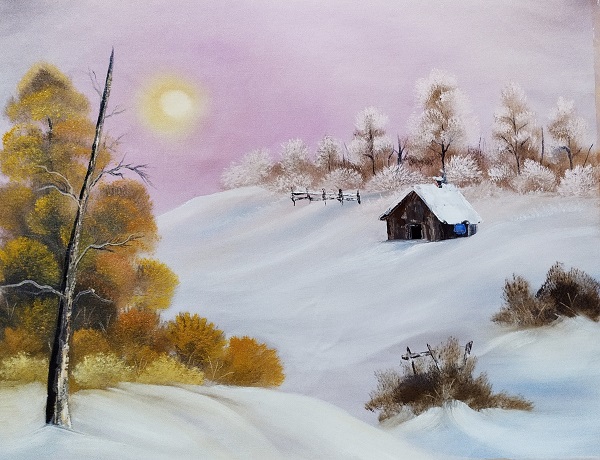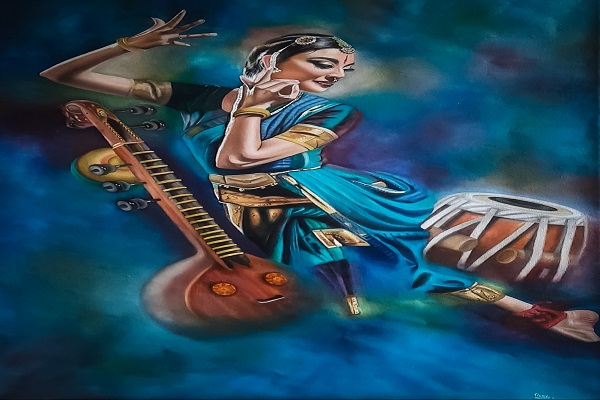
Making original artwork and expressing your ideas through oil paintings on canvas is a rewarding and enjoyable activity. You may, however, create your own abstract canvas painting at home, did you know that? You can accomplish this more quickly than you might imagine, and you'll have more control over the size and contour of your painting surface. In this blog article, we'll demonstrate how to create oil paintings on canvas from scratch using only the simplest tools and materials. We'll also go through some original ways to decorate and customise your canvas using paint, collage, stencils, and other materials and create an online art gallery of your own.
What will you need?
To create abstract canvas paintings or oil paintings on canvas you will need the following. Have a look!
- A wooden frame or stretcher bars: Your canvas is held and shaped by this framework. They are easily accessible in a range of sizes online or at art supply stores. As an alternative, you can make your own by sawing and joining four pieces of wood into a square or rectangular shape using wood glue. The size of the frame depends on how big you want your canvas to be. Also, you can adjust the wood's thickness to your liking.
- A square of cotton or linen fabric: This will serve as both your painting surface and the covering for your frame. In addition to having enough fabric on the edges for stapling or nailing, it ought to be big enough to cover the frame. You can use any smooth, tightly woven plain fabric. A clean, in good-condition old bed sheet or curtain, can also be recycled.
- A stapler or a hammer and nails: You will use these tools to firmly fasten the fabric to the frame. Depending on what you have on hand and what suits you best, choose either staples or nails. Ensure that they are long enough to pass through the wood and cloth without protruding too far.
- A pair of scissors: These are needed to trim the surplus cloth after taping or nailing it to the frame. Any extra fabric that can obstruct your painting or make it appear messy should be trimmed off.
- Primer: A sort of paint known as a primer shields the fabric so that it is prepared to be painted with other types of paint. It keeps the fabric from absorbing too much paint and aids in creating a smooth, level surface for your artwork. You can use acrylic gesso, a white paint that mixes well with other mediums including oil pastels, watercolours, and acrylic paint. You can use oil primer if you prefer oil paints to acrylic paints, but keep in mind that it takes longer for oil primer to cure than acrylic gesso.
- A paintbrush: Use this item to evenly coat the canvas's whole surface with primer. Use any paintbrush, regardless of size or shape, that best suits your needs after making sure it is clean and dry.
- A plastic sheet or newspaper: Use this to cover your work surface while priming and painting your canvas to prevent spills and stains. Make sure you cover them with something disposable or washable to prevent paint stains from damaging your table or floor.

Interesting Blog: Indian Oil Paintings: color Mixing Tips For Your Art
How do you make a Canvas?
To make oil paintings of your own or design an abstract canvas painting, you need to follow the below-given steps:
Step 1: First, spread the cloth over the frame and set it on a flat surface. Check the fabric for folds or wrinkles and make sure it evenly covers the frame on all sides.
Step 2: Place staples or nails down the edge of the cloth, about an inch apart, at regular intervals, folding one edge over the rear of the frame. Continue along the other edge, tightening the cloth each time to prevent any sagging or looseness in the centre.
Step 3: Place a staple or nail close to where two edges meet at a right angle and fold one corner of the fabric diagonally over the rear of the frame. Make sure there are no gaps or overlaps between the other three corners as you go along.
Step 4: Use scissors to trim away any extra fabric, leaving approximately an inch of cloth all the way around the frame's corners for safety.
Step 5: Carefully flip your canvas over and set it on a newspaper or plastic sheet on a flat surface where you wish to prime it.
Step 6: Apply a thin coat of primer evenly across the canvas's whole surface using a paintbrush. Pay close attention to completely covering all of the fabric's fibres without leaving any bare spots or drips.
Step 7: Depending on how porous the fabric is and how thick you want the painting surface to be, you may need to apply more layers of primer; however, wait until they are completely dry before doing so.
Step 8: You may now begin painting on your canvas and create an online art gallery of your own!

Also Check: Indian Oil Paintings- History of Paintings on Caves and Rocks
How do you Embellish and Customise your Canvas?
Having created your own canvas at home, you may now let your imagination run wild and personalise it using paint, collage, stencils, etc. With this, you can create intricate abstract canvas paintings or oil paintings on canvas. Here are some suggestions to get you motivated:
- Using various brushes, sponges, palette knives, etc., paint a vibrant abstract design with acrylic paints to produce various effects and textures. You can also add more water or medium to the paint to make it more fluid or translucent.
- Cut out shapes from magazines, newspapers, photographs, etc., and glue them to your canvas to create a collage. Using craft knives or scissors, cut out the necessary shapes. Layer or overlay them to give them greater depth and interest. Several of the collage's components can also be painted over to give them additional detail or to make them blend in with the background.
- Apply patterns or text on your canvas using stencils and acrylic or spray paint. Alternatively, you can create your own stencils by cutting out designs from cardboard or plastic sheets and purchasing them from art supply stores or online. You can also make negative areas on your canvas with tape or stickers and paint over them afterwards. When the paint is dry, take off the stencils to reveal clean edges.
- Add texture to your canvas by covering some of your painting with modelling paste, sand, glitter, etc. To apply the paste to the canvas and make various patterns or forms, use a palette knife or a spatula. To give the paste some colour, you can also add some paint to the mixture. To add some shine or gritty texture, you can also sprinkle some sand or glitter over wet paint.
- Draw geometric patterns or stripes with masking tape or painter's tape on your canvas before painting over them with contrasting hues. On the canvas, draw straight lines or angles with a ruler or a level, and then run the tape down them. You can also cut the tape into various shapes with scissors and arrange them on your canvas. Before removing the tape, paint various colours over the taped sections and allow them to dry completely.

Read More: Capturing Emotion Through Portrait Oil Paintings
Conclusion
These are but a few illustrations of how you can embellish and customise your abstract painting canvas at home. There are countless options! Have fun experimenting with various mediums and techniques to discover what incredible pieces of art you can produce. On IndianArtIdeas.in, you may get ready-to-hang canvas paintings created by renowned painters. It is an online art gallery that provides a variety of exquisitely made paintings by well-known painters.





















